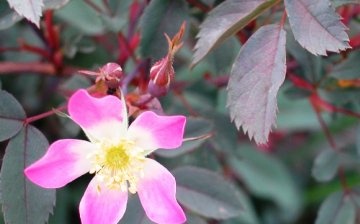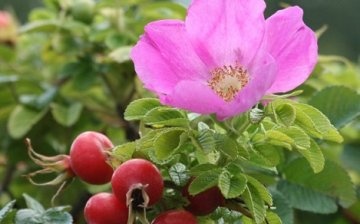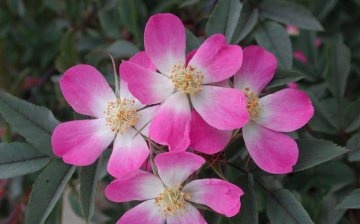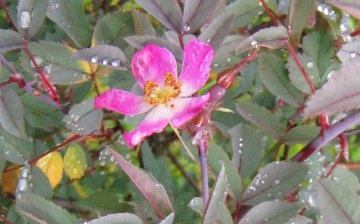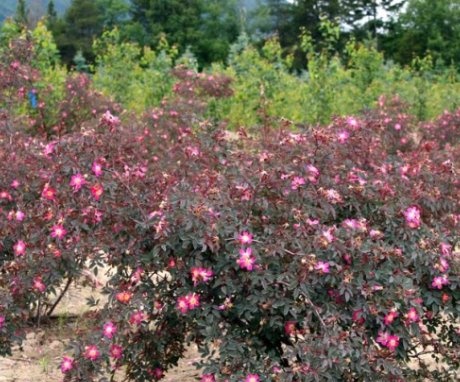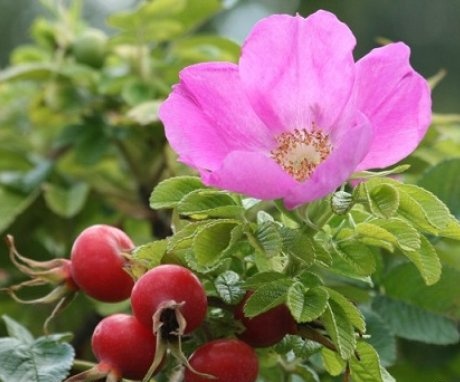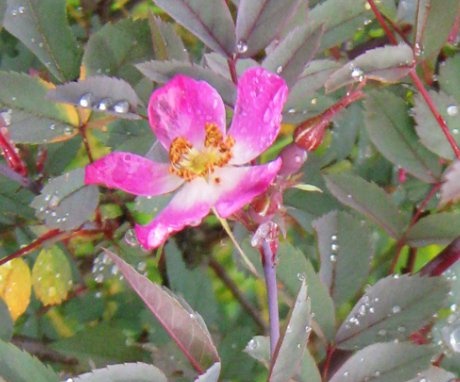Gray rose - an unpretentious shrub with decorative properties
Gray rose, she is red-leaved (Rosa glauca), refers to park roses (cultivated rose hips). In the wild, it can be found in the mountains of Asia and Europe. It is appreciated for its unpretentiousness to conditions cultivation and decorativeness.
Content:
Gray rose: description
Gray rose - bush up to 3 m high. Its thin shoots bend beautifully, which is why the bush resembles a vase or an open umbrella in shape. The crown diameter is 2.5-3 m.
Unlike cultivated roses, gray-gray attracts the eye not so much with flowers as with multi-colored lashes and leaves. In early spring, its leaves and stipules are red-purple, with a beetroot tint. Young shoots with thin thorns are of the same color. Gradually, the leaves acquire a gray-green color with a blue tint. Hence the name - gray rose. Adult shoots are not thorny, gray-brown in color. By autumn, the leaves will turn yellow or bright red. Their shape is typical for rose hips - pinnate. Each of them consists of 7-9 leaflets with a serrated edge and a pair of stipules adherent to the petiole.
The bloom of a rose with gray begins in June, and the bush is covered with a huge number of flowers.
Coloring - shades of pink. Each with five sepals, many pistils and yellow stamens. Near the base, the petals are light, almost white. The flower is small, up to 3.5 cm, almost odorless. Blooms for about two weeks. Three weeks after flowering juicy round fruits up to 2.5 cm in diameter are formed from the flowers. This is a converted receptacle (hypanthium). Angular inside the seeds covered with long and spiny hairs.
At first, the fruits are brown, but by autumn they ripen and become bright red, cherry. In this state, the fruits can be on the branches until spring, which makes the bush noticeable against the background of the gray colors of the surrounding landscape. Some sources call the fruit edible. It is not hazardous to health, but the spiky hairs inside, when it gets into the oral cavity, cause extremely unpleasant sensations. Therefore, you should not use the fruits for food. A gray rose can grow in one place for 30-40 years.
Reproduction methods
The gray rose reproduces seeds, dividing the bush, layering, cuttings... Does not form offspring.
Reproduction by seeds:
- Seeds are best harvested when the fruits are just starting to turn red. They are taken out, placed in a dish with wet sand and kept for 4 months (stratify) in a cool and not very damp room. The temperature there should not rise above 5 ° C. Periodically, the sand is loosened gently to allow air access. Moisturize as needed.
- It is possible to sow in the ground in spring or autumn to a depth of 3 cm. If you do this in the fall, the germination percentage is higher. The site is covered with a layer of humus. It will help retain moisture. Seed germination up to 17%.
- Plants with multiple leaves diveplanting at a distance of 8 cm from each other. After they grow, they begin to feed with nitrogen, phosphorus and potassium fertilizers.
The gray rose is propagated and cuttings, but only 30% of them take root after treatment with a growth stimulant BCI (0.01%). When using Epin, the survival rate is 63%.
Growing roses with gray
It is better to plant a blue-gray rose in a sunny place. But it grows well in partial shade. It will not bloom so profusely, but the leaves will take on a brighter color. Air should flow freely between the bushes. This will protect them from development. diseases... The soil must be well-drained. Gray rose grows best on loam, rich in nutrients, slightly acidic (pH 6-6.5). Feels great on calcareous soils. Therefore, if the soil is acidic, it is first lime.
The gray rose does not tolerate waterlogging.
Especially its roots are afraid of nearby groundwater. They should be no higher than a meter from the surface. A young one- or two-year-old seedling is planted in the south in the fall, in more northern latitudes in the spring, before the leaves have time to bloom. Plants sold in pots (closed root system) are planted all summer.
They are digging a hole half a meter deep. The removed soil is mixed with a bucket of humus, 300 g of lime (if the soil is acidic), a glass of fresh wood ash. Superphosphate (50 g) is added. Plants with open roots are carefully inspected. Broken stems and roots are cut. The stems can be cut strongly, and only the tips on the roots, freshened up. If they are dry, they are placed in a bowl of water for 24 hours. Immediately before planting, the root is immersed in liquid clay. A pile of prepared soil mixture is poured into the hole, the roots are leveled and covered with earth. Press gently so as not to damage the thin roots. Watered spud, mulch.
Shrub Care Tips
The buds begin to bloom in April. Blooms and bears fruit in the fourth year of life. Are regularly removed in the summer weeds, watered. The plant needs a strong root system in order to hold a large crown. Therefore, in the early years, they regularly loosen the soil under the bushes. The gray rose is frost-resistant, does not require shelter in winter. This is one of its main advantages.
Pruning tips:
- Every year in the spring, during the period of awakening of the kidneys, they spend pruning... It helps shape the crown. Usually at this time the average daily temperature reaches 5 degrees. Doing it earlier is not worth it, because the frozen branches will not be visible.
- Leave up to 7 strong shoots. Weak, growing inside the bush, damaged are removed with a sharp pruner at a distance of 1 cm from the eye directed outward from the center of the bush.
- At the end of August, you can carry out sanitary pruning by removing broken and weak shoots. But the main ones should not be shortened. After all, there are fruits that will decorate the bush after the fall of leaves.
- Over time, the bush loses its decorative effect. In order for the gray rose to please the eye as long as possible, rejuvenating pruning is carried out. The oldest branches are cut out, thin non-flowering ones are removed. Slices with a diameter of more than 1.5 cm are treated with garden varnish or oil paint. Pruning is carried out carefully, wearing strong gloves. After all, the plant has sharp thorns.
Promotes the strengthening of the roots regular feeding:
- In the summer, up to 4 times make the full mineral fertilizer, in the fall - humus.
- You can use the infusion mullein or chicken droppings... It is diluted 1:10.
- Roses are afraid of fertilizer overdose.
- Before feeding, the bush must be watered abundantly.
Useful video - Cutting roses.
Spraying before flowering, a growth stimulant promotes the formation of lateral shoots. In the future, they are added dropwise and used for reproduction by layering.
Pests the gray rose is almost not damaged.
If the leaves are spoiled by a cut sawfly or aphids have started up, the bush is treated with karbofos. On defeat powdery mildew sprayed with colloidal sulfur (0.7%).
Gray rose is used:
- In landscape design.
- how rootstock for roses of other varieties.
In gardens, it is planted in groups and in single plantings, next to plants that have a contrasting color of leaves. Hedges made of gray roses look good. Do not place close to or under tall trees.They are planted on the edges, used to decorate the walls of various buildings. Not afraid of urban conditions: strong gas pollution, dust. In the spring, the gray rose attracts attention with an abundance of flowers, in summer and autumn - the color of the leaves, in the winter - with bright fruits.



